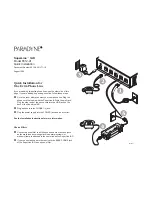
158
Login Target Filter 16G or Login Target Filter Ext
When FC-Switch is used, restrain unnecessary logging in to target ports from adapter ports. If this
parameter value is set to pid, the driver does not log in to target ports that have the same upper 2 bytes in 3
bytes of the PORT ID of the Adapter itself. This option may be effective on the FC-Switch without zonings,
for example, FC-Switches with Access Gateway mode enabled.
When FC-Switch is used with Access Gateway mode, the boot time of the OS might be prolonged because
unnecessary FC accesses arise between the FC ports that are not separated by zoning. If this option is set
to ‘pid’, the driver can decrease unnecessary access.
Please read Access Gateway mode in the manual of the connected FC-Switch.
Notice the following information when this feature is enabled.
・
Depending on the configuration of the FC-Switch, the upper two bytes of the PORT_IDs of the target port
of the connection destination and the adapter port of the connection source might correspond to each other
unintentionally. In the above setting, if this option is set to pid, login to the target port might fail. In such a
situation, change the setting of this option and the “Login Target Filter” (-p tf) so that the “Login Target Filter
Function” will be off, or reconfigure the upper two bytes of the PORT IDs on the FC-Switch not to
correspond to each other. After the configuration is complete, execute a Target Scan command, and then re-
recognize the target.
・
If 2G, 4G, or 8G Fibre Channel Adapter is used, this option does not make any effects. If 16G Fibre
Channel Adapters are needed to be configured, refer to the “Login Target Filter (-p tf)” entry.
Login Target Filter Function
This is displayed in Linux hfcmgr Ver. 8.9 or later, or in Windows hfcmgr Ver. 8.10 or later.
This parameter shows whether the function that suppresses login to a port connected to an FC-Switch
where the upper two bytes of the three-byte identifier (PORT_ID) correspond to each other is enabled ("on"
is displayed) or disabled ("off" is displayed). The setting of enabling or disabling is configured by using the
"Login Target Filter” (-p tf) and "Login Target Filter Ext” (-p tfx). The setting varies depending on the type of
adapter used. Refer to the following:
For 4G Fibre Channel adapters and 8G Fibre Channel adapters
Setting of the “Login
Target Filter”
Setting of the “Login
Target Filter Ext”
Login Target Filter Function
pid
pid
on
pid
none
pid
-
none
pid
none
none
off
none
-
For 16-Gbps Fibre Channel adapters
Setting of the “Login
Target Filter Ext”
Login Target Filter Function
pid
on
none
off
For 16-Gbps Fibre Channel adapters, you do not have to configure the setting for the Login Target Filter.
Depending on the FC-Switch, the upper two bytes of the PORT_IDs of the target port of the connection
destination and the adapter port of the connection source might correspond to each other unintentionally. In
such circumstances, login to the target port might fail. In such a situation, set the “Login Target Filter” (-p tf)
and “Login Target Filter Ext” (-p tfx) so that the “Login Target Filter Function” will be off, or reconfigure the
upper two bytes of the PORT_IDs on the FC-Switch not to correspond to each other.
Summary of Contents for GGX-CC9M4G2X1
Page 151: ...130 ...
Page 157: ...136 Example ...












































